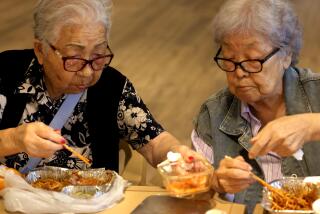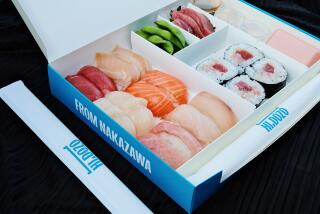Noshing in Japan--Virtually Free
- Share via
TOKYO — In this time of a weakened U.S. dollar and a more expensive Japanese yen, many visitors to Japan are missing a chance to eat cheaply.
It is possible not only to eat less expensively than one might have thought before leaving the United States, but to have a hearty and varied meal absolutely free.
Most experienced travelers are quite familiar with the food halls in the lower levels of many London department stores. They are often gourmet versions of our neighborhood supermarkets, containing fine meats, varied teas, sumptuous pastries and local specialties, all available for purchase, sometimes at prices that can make you blanch. Those British food purveyors, however, pale in comparison with their counterparts in Tokyo.
Most, if not all Tokyo department stores devote their basement levels, and sometimes two basement levels, to mammoth food sections selling virtually every delicacy your heart could ever desire, as well as some items your heart would probably never desire.
Raw Fish to Ice Cream
From cooked fish to raw fish to fried chicken to beef teriyaki to tempura to tea to wine to ice cream to cake, the items are seemingly endless. People can treasure the epitome of Japanese cuisine alongside the more familiar delicacies that have made Western palates salivate for decades.
A visit to a Japanese food hall might start in the pickle section. You will not find the kosher dill pickles so common in American delis, but you will see literally scores of kinds of pickled vegetables, both fresh and dried, spicy or mild.
After the pickle section, head to the fresh fish section where you can buy and sample not only sushi and sashimi but whole fish that would make the best seafood specialty store envious.
Near the fish section might be stands displaying tempura or yakitori or other prepared foods, and not far away are the meat counters where sausages, pork and some of the finest beef in Japan are displayed.
There may be grapefruits the size of oranges, grapes so tiny that you can’t help but imagine the bonsai vines that must have produced them, or bananas only a few inches long. Whatever the size or shape, the produce is invariably delicious.
International Delights
Near the fruit and vegetables may be sections dispensing soba and udon, two kinds of Japanese noodles. Also nearby are likely to be wide varieties of packaged items such as cooking oils and sauces, as well as items imported from the United States and Western Europe. Many Japanese department stores have branches of Paris’ Fauchon, London’s Fortnum and Mason or Munich’s Dallmayr.
Many Americans are not satisfied unless they can sate their sweet tooth. Not to worry. Ice cream, including Haagen Daz and Frusen Gladje, is often available. Cakes of all types and sizes are sold everywhere. One might find chocolate cakes and cheese cakes more easily in some of the stores than in some parts of the United States. A plethora of different cookies and candies are also on display.
In addition to the sweets with which Americans are familiar, a wide variety of Japanese desserts are available such as various kinds of bean paste-based treats. Two examples are yatsuhashi, a concoction in which a thin, cinnamon-flavored cake is rolled and filled with bean jam, and sobamanju, a buckwheat bun filled with sweet bean jelly.
Tea, Wine, Liquor
If all this is making you thirsty, many of the food halls have juice bars and all have special sections selling green tea and wines and liquors. The green tea will include the highest quality, maccha or gyhokuro, and lesser-quality versions such as sencha or bancha. Alcoholic beverages include both Japanese items as well as France and Italy’s finest wines.
What will make the Japanese food hall especially exciting for many Americans is the wide range of samples that are virtually pushed at you as you stroll the aisles. Not the occasional cheese or cracker sample handed to you at your supermarket, but samples given at counter after counter.
A brief walk through a food hall will almost certainly offer you tastes of sushi, sashimi, pickles, noodles, fruit, caviar, chicken, fish, cake, candies. And to wash it all down, a cup of green tea or a glass of fine wine.
In some stores you may also be given assorted tempura, fried chicken, grilled fish or broiled beef. Sometimes the sample is intended to introduce you to the primary ingredients, and sometimes it is the dipping sauce, marinade or cooking oil that is intended to be the star.
In the better food halls, you can in effect eat free, especially if you believe in light lunches or you’ve already had a big breakfast. Even if you are not entirely sated by the free samples, a minimal outlay will produce a couple of extra items to fill out your meal.
For example, a skewer of yakitori, similar to barbecued chicken, costs about 70 cents; a couple of pieces of tempura would be similarly priced.
Assortments to Go
For those who feel they need more, a popular Japanese favorite readily available at all the food halls is the obento, or Japanese lunch box. This is a small box containing sushi, sashimi and related items. Prices can range from a couple of dollars to $20 or $30, depending on the size and quality of the assortment you buy. A $30 assortment is probably enough to feed several people.
Not all of the food halls are of equal quality. In Tokyo, three of the best are in the Isetan Department Store (Shinjuku branch), the Takashimaya Department Store (Nihonbashi branch) and the Mitsukoshi Department Store (Nihonbashi branch). All are accessible by the subway system and on a rainy or cold day can be reached from the subway without going outside.
Isetan is a short walk east of the Shinjuku Station, Takashimaya is directly above the Nihonbashi stop and Mitsukoshi is directly above the Mitsukoshi-mae stop.
The Nihonbashi branches of both Takashimaya and Mitsukoshi are excellent choices for doing your shopping for Japanese products, including fashions, lacquerware, pottery and other traditional items. So the visitor can combine a shopping excursion with a sightseeing tour of the store’s food hall.
Supermarket Sampling
Be alert to the possibility of a food hall anywhere, not just in department stores. Many of the larger supermarkets may give samples, although probably not to the same extent as the department stores.
In addition, there are food halls independent from department stores. For example, Tokyo’s Shibuya station, which serves two subway and five rail lines and is near several trendy fashion stores, including Parco and Fashion Community, has a food stall that although not as large as some of those in department stores will nevertheless offer you a large variety of items.
The food hall is not only in Tokyo. In virtually every large city and many smaller cities, you’ll find food halls often as large as the best Tokyo has to offer.
More to Read
Sign up for The Wild
We’ll help you find the best places to hike, bike and run, as well as the perfect silent spots for meditation and yoga.
You may occasionally receive promotional content from the Los Angeles Times.






